Questions & Answers Based On International Trade & Enterprise
Question
Task:
The questions to be answered are;
Question 1: World Trade Overview and Gravity Model
In the 19th Century Britain was trading with countries from distant locations such as North America, Latin America, Africa and Asia. Today, Britain mostly trades with European countries. Examine the causes of the British changing trade pattern with reference to the Gravity Model.
Question 2: Resources and Trade: Heckscher-Ohlin (H-O) Model
How does the Ricardian model differ from the H-O theory in explaining international trade patterns among nations?
Question 3: Economies of Scale, Imperfect Competition and International Trade
Trade need not be the result of comparative advantage but it can be a result of economies of scale. Discuss.
Question 4: International Factor Movements
Explain the effects of migration of labour between two nations. Use the figure below and the marginal product of labour concept to explain your answer.
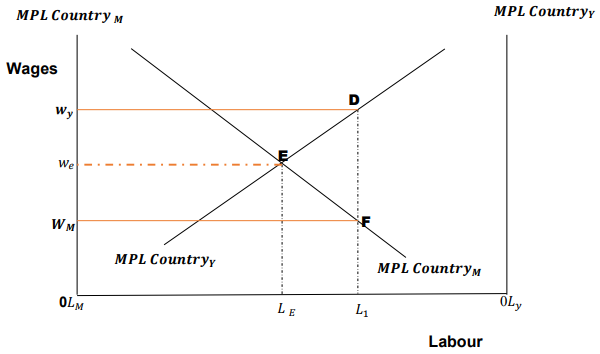
Question 5: Trade Policy in Newly Industrialized/Developing Countries
Infant Industry protection is a key solution for the growth of industrialization of developing countries. Discuss your answer by using the graph below and any other graph(s) that you can deem appropriate.
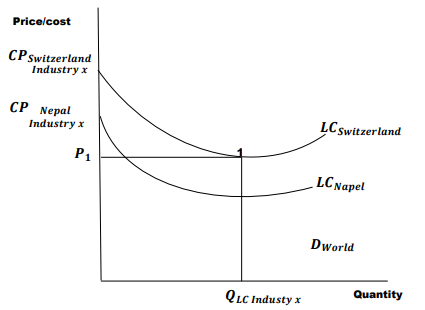
Question 6: Controversies in Trade Policy
After the Seattle 1999 World Trade Organization Ministerial Conference fiasco, in the next 2 years, large anti-globalization demonstrations rocked the International Monetary Fund and Work Bank in Washington. What was the anti-globalization movement goal- and was it right? Explain you answer and where appropriate use figures.
Answer
In the current business world, with the advancement of technology, companies are projected to expand their business in the international trade scale. However, there are certain aspects that companies need to consider while expanding their business globally. Such aspects have a large impact on the business and play a key role in successful business expansion. The following business detonates various theories and aspects are discussed related to world trade by addressing a range of questions.
Answer 1: World Trade Overview and Gravity Model
Overview of World Trade:
World trade is referred to the legal exchange of any goods and services on the international level. It is a very important aspect because it allows a nation’s market to deliver goods and services diversity to fulfil the consumer’s needs. Trade and foreign policy have been interrelated throughout history and foreign policy is primarily designed to promote trade interests. (Anderson, 2018). In the third century BC, during the Han Dynasty, China maintained the Silk Road for trade with its military power. In the middle of the sixteenth century, a philosophy supporting international trade appeared in England. This theory, known as mercantilism, states that gold and silver are the basis of a nation's wealth and are important for healthy and active business activities (Anderson, 2018). In Geneva on January 1, 1948, to use import quotas from 23 countries and to reduce trade tariffs. Although the GATT is considered temporary, it is the only major agreement to maintain international trade until the formation of the World Trade Organization. The GATT system has evolved over 47 years and has become a real-world trade organization with approximately 130 countries (Anderson, 2018). From the early days of the Silk Road to the formation of the General Agreement on Customs and Trade and the birth of the World Trade Organization, world trade played an important role in promoting peaceful relations and economic development between nations.
Gravity Model:
The gravity model is commonly used by international and local economists to study the trade and its patterns along with the changes have occurred with time. It was first introduced by Jan Tinbergen in 1962, with the help of Newton's theory of gravity. The theory suggested that the intensity of bilateral trade flows between any two countries could be calculated using the 'gravity equation'. The gravitational pull has long been used to describe bilateral trade in goods. The model of gravity in economics is relatively recent, and the intelligent orphan is not associated with great economic theory (Delbourg and Dinar, 2020). The Gravity Bridge model attracts countries to trade with each other, while at the same time weakening the attraction to greater distances. These include the Ricardian model, which describes trade methods based on differences in technology distribution, and the Heckscher -Ohlin model, which relies on differences in trade - based assets between countries. The theoretical basis for the use of gravity patterns in commercial literature is provided by the works of Eric van Wincoop and James Anderson. Similar product prices vary due to various trade costs. These business costs include not only transportation costs, but also design costs, information costs, and various regulatory and legal costs (Almog et al., 2019). The solution of the model gives the gravitational equation of the form. The stability of the gravitational equation and the ability to describe bilateral trade flows have led to the development of models that can connect the model.
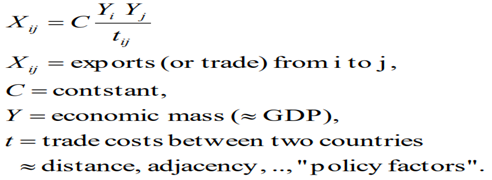
Fig: Intuitive gravity for trade
Source: (Almog et al., 2019)
The trade pattern of the UK has changed significantly over the years. In between the period of 1880 to 1940, it was not easy to predict whether trade between countries, capital inflows, and migration at international level would be optional or must needed aspects, however, they explicitly reject trade and labour as an alternative, the conclusions between capital and flows are not very clear. Various researches point out that there are real historical implications for trade and immigration policy. The commodity market consolidation factor, along with price mobilization, especially concerning the wage rate of landowners, increased in labour-intensive, land-less Europe, but reduced the labour deficit in the land-rich nations, thanks to migration at international level, and various trade and investment (Almog et al., 2019). The economic performance of the African regions most affected by the slave trade which was negatively affected, by the indirect effects of two different approaches: state capacity building and racial segregation. In Western Europe, in the "middle corner" of the Triangle of Atlantic, trade was not enough to promote economic growth through direct capital accumulation or sustained profits from trade, but it increased the burden on traders in the political process and led to trade-friendly institutional arrangements and ultimately political equilibrium for economic development (Cipkute, 2016). There was a huge difference in trade patterns in the UK in the nineteenth century after the post-industrial revolution also after the various trade losses after the World War and in current trade patterns. At the colonial age, Britishers had expanded its business territory overseas with the establishment of the political regime of their own. However the comparison to current trade patterns they are most likely to focus on doing business within Europe but after the colonial age, they most prefer to do business within the worldwide because of the availability of FTA’s (Delbourg and Dinar, 2020). In terms of distance those countries are far situated from the country thus doing export and import likely to be much difficult in the nineteenth century because of the less availability of advance transportation along with the cost which more likely to higher in those countries like China, India, Australia, etc. At that time doing business in Europe was a lot easier and more likely to be non-expensive. But these trade pattern changes over time with the advancement of new technologies along with the advancement of infrastructure as well (Cipkute, 2016). Thus, the cost is much lower. Also, because of various FTA’s and Bilateral treaties with various countries trade cost is lower than the nineteenth century however the nature of trade is much more complex. There are various duties imposed in the trade which are not likely not there in the nineteenth century but it has less indirect cost along with a much more controlled price than before (Cipkute, 2016). All these factors made the change the trade patterns of over the decade.
Answer 2: Resources and Trade: Heckscher-Ohlin (H-O) Model:
The Ricardian model is based on Adam Smith theory. It is a modification of Smith’s Absolute Advantage theory. According to Smith, trade benefits are when countries produce a certain profit at a lower cost than their foreign counterpart and trade with a product that cannot be produced at a lower cost in such country. A country that does not have the full benefit of international trade can still benefit from trade, but David Ricardo's model has been relatively improved than Smith’s theory. It mainly focuses on the advantages of competition. According to this model of comparative practice, technology distinguishes productivity of the labour (Gumpert and Wink, 2020). The model states that countries are particularly focused on producing the best products and services possible. The model also suggests that trade between countries is driven by differences in labour productivity due to technical differences. The model treats labour as the sole element of production. The limitation of this model is that it only applies for a short period as the technology changes internationally over time. The Ricardian comparative advantage proves to be a profitable solution for owners because it requires different components of infrastructure and material production (Gumpert and Wink, 2020). However, not all countries see the need to trade with each other.
The Heckscher-Ohlin model is a model of mathematical aspects that explain international trade, which is developed by Eli Heckscher and Bertil Olin. Based on David Ricardo's theory but by reversing production and trade methods. The model states that countries that export products use their cheap, bulk production and imported product components. Production factors such as capital and labour determine the relative profitability of a nation. Unlike the Ricardian model, this model proposed by Heckscher-Ohlin, explains that production has two components, labour and capital. The model states that countries need to use a lot of resources for the production and export of goods (Król, 2019). Similarly, countries need to import goods that require resources in their short supply. Since commodity profits are based on input costs, countries have better production needs than locally available production factors. Ingredients that require input are cheaper than products that require input. This model has a different approach than Ricardian theory because it focuses on the production processes’ efficiency. More broadly, high-capital countries specialize in capital-intensive products, and high-labour countries specialize in products that are labour-intensive and most likely they trade with each other (Król, 2019). The model assumes that capital and labour to flow freely between regions and that the magnitude of labour and capital factors varies between countries. The model also has an assumption that advanced and developed countries generally use the same technologies.
Answer 3: Economies of Scale, Imperfect Competition and International Trade:
International trade refers to the transfer of capital, goods and services across international borders or territories. Business partners gain mutual benefits as each country specializes in relatively profitable products and engages in trade for other products. If referred the all the trade data, it can be seen that most of the countries in global level are more likely exporting as well as importing similar products. Trade between countries does not depend solely on economic differences. For this reason, economic scale models are used to account for trade between countries (Bartelme et al., 2018). The economic criterion describes the cost benefit a company experiences when increasing its output. Profit is due to the inverse relationship between per unit fixed price and output. As output increases, the fixed price per unit decreases. Economies of scale are higher than the average variable cost of production. It provides synergy and efficiency as a result of increased product volume. At the production process, Scale of economics can be implemented at any stage. In this current scenario, economic concept refers to commodity and includes all activities related to the commodity, regardless of the end buyer (Bartelme et al., 2018). It helps to reduce the fixed cost per unit by describing the economic effect on the level of production cost. As a result of increased production, fixed costs have spread to higher output than ever before and also reduces unit variable costs. This is because the production process becomes more efficient as output increases. Although there are no differences in technology or resources from in different countries and trade between industries can be explained in terms of scale and other product economies. This model is called monopoly comparative model (Suranovic, 2019). It focuses on consumer demand for the various features included in products sold in the targeted segment. In this model, even if the productivity of the country is very similar, comparative trade can be achieved with different products. Large economies are often found in industries with high production costs (Suranovic, 2019). Even if the output is zero, the fixed cost is a cost that should be minimized. It can be argued that when countries apply the principle of comparative practice, world production increases to determine the goods and services needed to acquire specific expertise in production. For clarity of expression, the principle of comparative practice generally emphasizes that only two countries and two objects are included first, although policies are not limited to such phenomena. Also, the cost of production is usually calculated in terms of labour time and effort. Economic theory states that if countries follow a comparative approach if both countries strive for self-sufficiency and allocate resources for the production of two commodities, overall production will increase compared to production. The so-called comparative advantage of the country at the lowest possible cost for any purpose (Bertrand, 2019). Comparative advantage affects not only the output results of trading countries but also commodity prices. The comparative advantage suggests that nations should behave in the same way. Workers in the United States are relatively highly educated and have relatively extensive capital resources which represent them as highly productive. However, this does not mean that the American consumer must produce everything the American consumer needs. Instead, maximum efficiency and expertise can be gain by reducing opportunity costs in those areas and doing business with other countries. This maximizes the benefits of specialization while eliminating high costs. These costs include transportation costs and external costs associated with trade (Awan and Zahra, 2018). The theory suggests that the market is perfectly competitive. In particular, factors that do not reduce revenue or transportation costs are increasing reasonably. The output of the factor input is affected by the reduction in revenue, the reality is very different from the cost of transportation. Specialization can lead to structural unemployment because some workers are unable to move from one sector to another. The theory does not take into account exchange rates and relative prices. It is not a static concept because the country can develop new dominant trades and may change over time (Awan and Zahra, 2018). So based on such, Trade need not be the result of comparative advantage but it can be a result of economies of scale.
Answer 4: International Factor Movements
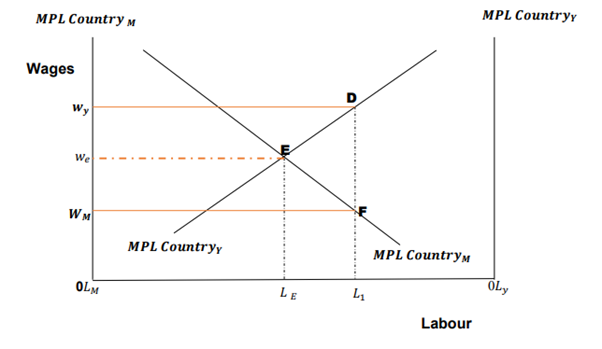
When the migration of labour between the two countries is concerned, the marginal product of labour or MPL can be used to understand the impacts of international labour mobility. As shown in the graph above, is M is considered as a home country and y as the foreign country the labour force for home country is situated at point F and for the foreign country it is situated at point D. when there is no labour migration these points would remain same. When force lours migrate from home to a foreign country with no cost of movement which is taken as ‘0’the point intersects and the real wage of labour force emerges at point E (Annachhatre, 2020).
As a result of this, some economic benefits can be observed. As per the graph above Wy is the wage under full migration. In this instance, the home country is at an advantageous position because Wy is lower that MPL of the home country and at the same time a foreign country is also at an advantageous position. After all, Wy is higher than the MPL of migrants.
Taking Home country, for example, immigration can be given by
?Q = 1/2 (We? Wy) (L1-LE)
After rearranging equation stands at
?Q/ Q= - 1/2 sem2
When S is considered as the national income share by labour and wage elasticity is represented by e and the foreign-born fraction of the labour force is represented as
m = (L1-LE) /LE,
Putting the values of s = 70%, m = 10% and e = ?0.3 (Annachhatre, 2020),
The benefit of migration is calculated as 0.1% of GDP
Therefore, referring to the graph above, the direct impact of labour migration can be determined as beneficial.
Answer 5: Trade Policy in Newly Industrialized/Developing Countries
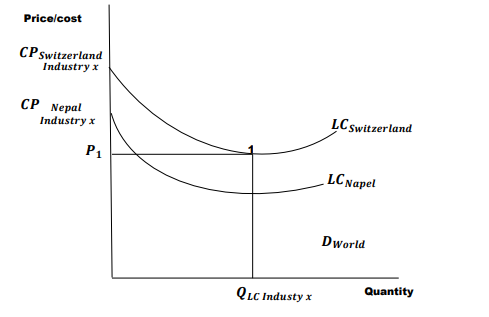
For developing countries, it is appropriate to put tariffs on all imports if they are looking for diversification of new industries (infants) and developing new products. This is the key argument behind the concept of infant industry for developing countries. However, developing countries can only create a comparative advantage when they create economies of scale and infrastructure (Ravikumar et al., 2018).
In the above graph, two examples have been taken. Switzerland is a developed country and Nepal is a developing country. LC represents the tariffs and CP represents the price or costs of production. The average cost of production for a certain quantity is always higher for the infant industry and it is much higher in developed countries than developing ones as shown in the graph. However, when tariffs are imposed, these costs can be lowered to a point when no tariff protection is required. This gives many benefits to developing countries. Through tariff protections, developing countries can expand and obtain lowered average costs on imports allowing them to diversify and create economies of scale (Abdelkader et al., 2018).
Answer 6: Controversies in Trade Policy
The anti-globalisation movement started when protestors to globalisation took a stand against global capitalism. The protestors protested against all types of international financial institutions such as WTO. However, critics of this movement suggested that the naming is incorrect as the movement does not object to the concept of globalisation but objects to capitalism, and unfairness it causes towards the poor while giving unregulated and unfair advantages to the capitalists. One of the major arguing points for protestors was that capitalists have recruited low wage labour force from other countries (migrant workers) while taking jobs away from its countrymen. The right name for the movement has been suggested as a proactive movement towards global justice and democracy. The major concern of the protestor was against the corporate drive in the international free trade. Most protestors were not against free trade but raised concerned against the boundless power the agreements were given to the capitalists (Antentas, 2016). For the corporate, the national safety standards and other labour protection rights were deemed as barriers to trade for which free trade at any cost was being proposed. Unfair media coverage to the protests projected the protestors as protesting to the very idea of globalisation while mainly the protestors were protesting against the rules of trade being made at the expense of the poor. The illegal concentrations of public and privet power and unequal distribution of wealth that the free trade laws would cause were the main concern of the movement (Macgregor-Bowles, and Bowles, 2017).
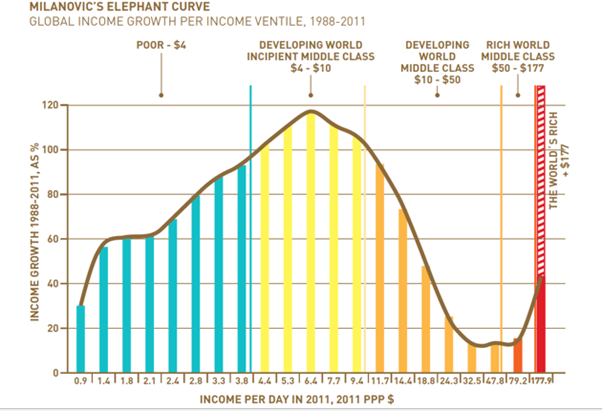
Figure: Milinkovic’s elephant curve explaining globalisation for the middle class
Source: (Birdsall, 2017)
Refereeing to the above graph it can be said that globalisation has been advantageous for middle-class strata in the developing graph as open markets have fuelled the growth of the economy thus lifting people from poverty. However, for the rich world, the gains in average real income were far less than 20% and thus not very prosperous (Birdsall, 2017).
Considering all these aspects it can be stated that the aims of the anti-globalisation movements were right but the unfair presentation of the protests represented the aims as opposing the idea of globalisation.
References:
Abdelkader, M., Fisher, G., Fawzy, S. and Atallah, G., 2017, August. Infant Industry Argument: Theoretical Framework and Current Opportunity of Adoption. In 3rd International Conference on Social Sciences Economics and Finance on 26th-27th August.
Almog, A., Bird, R., and Garlaschelli, D., 2019. Enhanced Gravity Model of Trade: Reconciling Macroeconomic and Network Models. Frontiers in Physics, 7.
Anderson, K., 2018. World Trade Organization (WTO) | History & Facts. Encyclopædia Britannica.
Annachhatre, M., 2020. Factor Mobility and Income Redistribution.
Antentas, J.M., 2016. Internationalist challenges: antiglobalisation, occupy, and indignados. Globalizations, 13(4), pp.469-483.
Awan, A. G., & Zahra, S., 2018. IS COMPARATIVE ADVANTAGE SUSTAINABLE IN INTERNATIONAL TRADE?. Global Journal of Management, Social Sciences and Humanities Vol, 4(3).
Bartelme, D., Mit, A., Donaldson, D., and Rodriguez-Clare, A., 2018. External Economies of Scale and Industrial Policy: A View from Trade * -PRELIMINARY AND INCOMPLETE.
Bertrand, T.J., 2019. International trade - Simplified theory of comparative advantage. Encyclopedia Britannica.
Birdsall, N., 2017. Middle Class: Winners Or Losers In A Globalized World?. [online] Center For Global Development. Available at:
Birdsall, N., 2017. Middle Class: Winners Or Losers In A Globalized World?. [online] Center For Global Development. Available at:
Delbourg, E. and Dinar, S., 2020. The globalization of virtual water flows: Explaining trade patterns of a scarce resource. World Development, 131, 104917.
Gumpert, M. and Wink, R., 2020. Ricardian model theory under different transfer forms and input factors. Economic Research-Ekonomska Istraživanja, 33 (1), 579–603.
Król, K., 2019. International Journal of Tax Economics and Management Trade Theory in International Economics. Sage Publications.
Macgregor-Bowles, I. and Bowles, D.C., 2017. Trump, Brexit, Right-wing anti-globalisation, and an uncertain future for public health. AIMS public health, 4(2), p.139.
Ravikumar, B., Riezman, R. and Zhang, Y., 2018. Optimal Infant Industry Protection. In 2018 Meeting Papers (No. 1016). Society for Economic Dynamics.
Suranovic, S.M., 2019. Trade: Chapter 80-0: Economies of Scale and International Trade - Overview [online]. Internationalecon.com. Available from: http://internationalecon.com/Trade/Tch80/T80-0.php [Accessed 3 Oct 2020].












